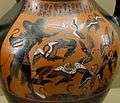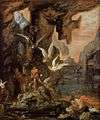Stymphalian birds
_06.jpg) | |
| Grouping | Legendary creature |
|---|---|
| Sub grouping | Birds |
| Mythology | Greek mythology |
| Country | Greece |
| Region | Arcadia |
| Habitat | Lake Stymphalia |
The Stymphalian birds (/stɪmˈfeɪliən/ stim-FAY-lee-ən; Greek: Στυμφαλίδες ὄρνιθες, Stymphalídes órnithes) are a group of voracious birds in Greek mythology. The birds' appellation is derived from their dwelling in a swamp in Stymphalia.[1][2]
Characteristics
The Stymphalian Birds are man-eating birds with beaks of bronze, sharp metallic feathers they could launch at their victims, and poisonous dung.
These fly against those who come to hunt them, wounding and killing them with their beaks. All armour of bronze or iron that men wear is pierced by the birds; but if they weave a garment of thick cork, the beaks of the Stymphalian birds are caught in the cork garment, just as the wings of small birds stick in bird-lime. These birds are of the size of a crane, and are like the ibis, but their beaks are more powerful, and not crooked like that of the ibis.
Mythology

These birds were pets of Artemis, the goddess of the hunt or have been brought up by Ares.[4] They migrated to a marsh in Arcadia to escape a pack of wolves. There they bred quickly and swarmed over the countryside, destroying crops, fruit trees, and townspeople.
The Sixth Labour of Heracles
The Stymphalian birds were defeated by the hero Heracles (Hercules) in his sixth labour for Eurystheus.[5][6] Heracles could not go into the marsh to reach the nests of the birds, as the ground would not support his weight. Athena, noticing the hero's plight, gave Heracles a rattle called a krotala, which Hephaestus had made especially for the occasion. Heracles shook the krotala (similar to castanets) on a certain mountain that overhung the lake and thus frightening the birds into the air.[7] Heracles then shot many of them with feathered arrows tipped with poisonous blood from the slain Hydra. The rest flew far away, never to plague Arcadia again. Heracles brought some of the slain birds to Eurystheus as proof of his success.[8][9][10]
The surviving birds made a new home on an island of Aretias in the Euxine Sea. The Argonauts later encountered them there.
According to Mnaseas,[11] they were not birds, but women and daughters of Stymphalus and Ornis, and were killed by Heracles because they did not receive him hospitably. In the temple of the Stymphalian Artemis, however, they were represented as birds, and behind the temple there were white marble statues of maidens with birds' feet.[12]
In popular culture
- In the 2003 real-time strategy game Age of Mythology: The Titans, the birds are available as flying units for the Atlantean culture.[13]
- In the 2005 Hercules miniseries, these birds are portrayed as harpies, while in the 2013 Atlantis TV series, they are portrayed as pterosaurs.
- They also make an appearance in The Sea of Monsters, the second novel in the Percy Jackson and the Olympians book series by Rick Riordan.
- The birds feature in the episode 'Before The Flood' of the 1980s animated TV series Ulysses 31
Gallery
 Hercules and the Stymphalian Birds' by Gustave Moreau, c 1872
Hercules and the Stymphalian Birds' by Gustave Moreau, c 1872- Kayseri Herakles Lahdi
- Hercules Killing the Stymphalian Birds by Albrecht Dürer (1500)
 Heracles and the Stymphalian birds. Attic black-figure amphora, 500-490 BC
Heracles and the Stymphalian birds. Attic black-figure amphora, 500-490 BC Heracles killing the Stymphalian birds with his sling. Attic black-figured amphora, ca. 540 BC. Said to be from Vulci.
Heracles killing the Stymphalian birds with his sling. Attic black-figured amphora, ca. 540 BC. Said to be from Vulci. Hercules at Lake Stymphalos by Gustave Moreau
Hercules at Lake Stymphalos by Gustave Moreau- Herakles erlegt mit Pfeilen die stymphalischen Vögel
References
- ↑ Strabo. Geographica, Book 8.6.8
- ↑ Pausanias. Description of Greece, 8.22.4
- ↑ Pausanias. Description of Greece, 8.22.5
- ↑ Servius. ad Aeneid. Book 8.300.
- ↑ Tzetzes. Chiliades, Book 2.291 ff
- ↑ Hyginus. Fabulae, 30
- ↑ Scholia. ad Apollonius, Argonautica, Book 2.1053. The use of a brazen rattle to frighten the birds was mentioned both by Pherecydes and Hellanicus
- ↑ Pseudo-Apollodorus. Bibliotheca, Book 2.5.6
- ↑ Quintus Smyrnaeus. Posthomerica, Book 6.253 ff
- ↑ Apollonius of Rhodes. Argonautica, Book 2.1052-1057
- ↑ Scholia. ad Apollonius, Argonautica, Book 2.1054
- ↑ Pausanias. Description of Greece, 8.22.7
- ↑ "Age of Mythology Heaven: Atlantean Myth Units". aom.heavengames.com.
Sources
- Greece: I Ancient,” in The New Grove's Dictionary of Music and Musicians, London 2001, vol. 10, 344-348
External links
